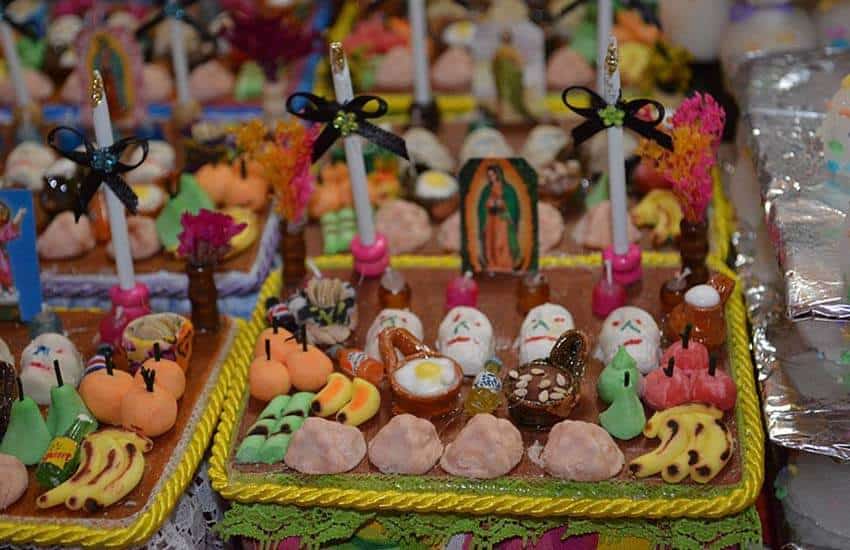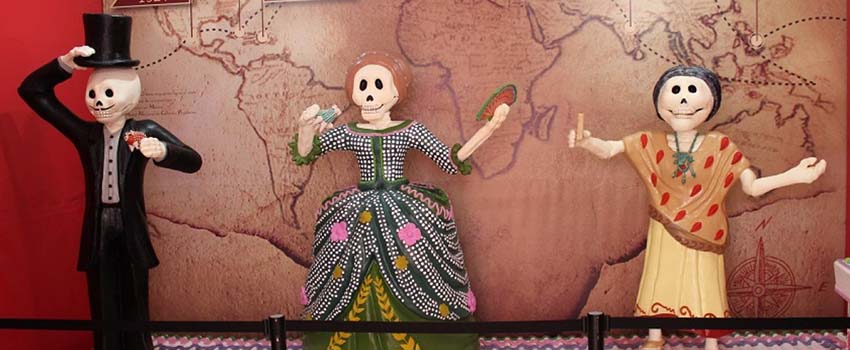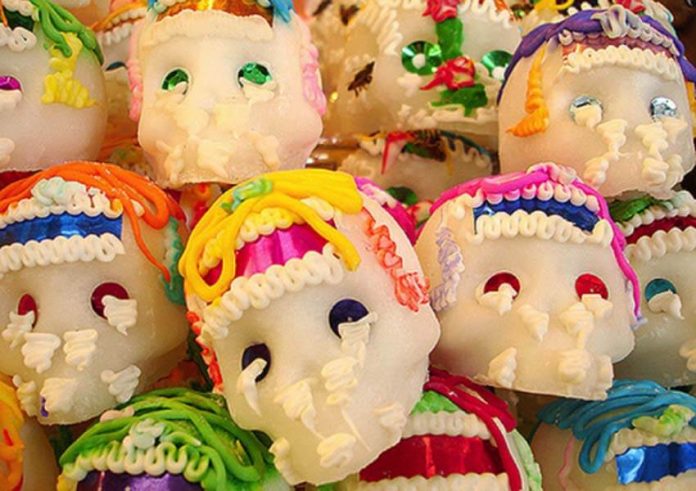It is almost a given to say that Mexicans can be creative with just about anything, even with something as common today as sugar.
So how did it get intimately connected to Day of the Dead?
In October, traditional and temporary markets (tianguis) overflow with paraphernalia for this holiday, and sugar skulls are prominent, along with Mexican marigolds (cempasúchil), papel picado (colorful decorative paper cutouts), pan de muerto (bread of the dead), incense burners, skeletons in all kinds of materials, candles and more.
This use of sugar is far more about art and ceremony than it is about something to eat.
The figures are like Day of the Dead itself, a syncretism of indigenous and European traditions and beliefs. Physically, their origin is with the creation of molded offerings made with amaranth seed, agave syrup and human blood by ancient indigenous peoples.

Spanish evangelists co-opted this idea a bit, equating them with Catholic rituals — e.g. the use of the ceremonial host and wine, which represent the body and blood of Jesus Christ — but then forbade the consumption of amaranth and human blood. What was left was the sweet part. Agave was replaced by cane sugar after the Spanish introduced this crop.
The making of skulls and other forms for Day of the Dead is not part of any official Catholic rite but rather “folk religion,” semi-sacred observations that coincide with many of the dates on the Catholic calendar.
Both Mesoamerican and European cultures had ritualistic observations related to the dead around the same time — the end of October and early November. This is because the end of the growing season occurs roughly at the same time: in Europe, it’s due to the onset of cold weather, and in Mexico because of the end of the rainy season.
In both cases, the “death” of the fields, and the bounty they provide, became associated with ancestor veneration — both literally and as a homage to the past. Day of the Dead, Halloween (in its original form) and All Saints’ Day/All Souls’ Day are all holidays that serve as reminders that everything living eventually dies.
Fruits of the harvest are prominent on Day of the Dead altars, along with photographs of those being remembered and other decorations. Sugar cane is part of the harvest, but it also serves as a preservative, so candied fruits, as well as squash and sweet potatoes in syrup, are also traditional. Sugar was relatively expensive in the colonial period, so using it to make skulls and other figures acted as a kind of offering.
By far, the most popular sugar figures are highly decorated skulls, generally with a space on the forehead for adding a name when the skull is bought.

That name can be of someone living or dead. If the name is of the dead, the homage is obvious, but why put the name of someone who is alive?
It certainly is not to wish another person dead.
The conceptual line between life and death in Mexico is thinner than in Anglo cultures. If the recipient is a child, gifting of a sugar skull serves as a lesson that death is part of life. They are more often given as tokens of affection among coworkers and adult family members.
There is also no rule against buying one and putting your own name on it.
If you have tried eating a sugar skull, or anything else made with the paste, you were probably disappointed that it did not taste like rock candy. (I know I was.)
The sugar paste is called alfeñique, which can translate as “sweets,” and rather than being pure sugar, it is powdered sugar mixed with egg white and — depending on where you are in Mexico — possibly Porophyllum ruderale, a native plant with glue-like properties. These additions allow for a paste that can be molded by hand, something not possible if mixing sugar only with water.

Alfeñique artisans all have their own recipes, and the best concoctions result in something that has properties not unlike clay, allowing for figures that it’s hard to believe are made from sugar.
Alfeñique skulls and figures can be made completely by hand, but the use of molds for the basic shape is very common. Painting and the addition of raised decorative elements are typically done manually.
After skulls, the most common sugar figures made are skeletons, many of which are sculpted to show them doing activities of the living in a comical way. Other figures include angels, devils, domestic and wild animals, the Virgin of Guadalupe, crosses, tombs and even miniature representations of common Day of the Dead altar offerings.
The artisans can be found all over Mexico, especially in the center and down into Oaxaca and Chiapas. However, the small industrial city of Toluca in México state has developed a nationwide reputation for preserving this craft in a myriad of forms.
Toluca is home to the annual Fería de Alfeñique and a museum dedicated to the craft. Organizers have confirmed that it will be taking place this year, from October 15 to November 2.
There are various events, but most come to see the myriad of stalls that occupy the walkway around the Portales de Toluca, a complex of buildings behind the city’s cathedral that hosts shops and restaurants.

Here you will see a wide variety of alfeñique in traditional and innovative forms, as well as just about anything you might need for your altar. They also have skulls made from other edibles such as amaranth seed (no blood, sorry), chocolate and tamarind paste.
For alfeñiqueros (alfeñique artisans), the month of October is absolutely critical for the survival of their craft. There is no other holiday or event for which the sugar paste is used.
Even with good sales, it is not easy. Many of the stalls in Toluca and other markets now also sell masks and other stuff related to Halloween, much to the chagrin of traditionalists.
Leigh Thelmadatter arrived in Mexico 18 years ago and fell in love with the land and the culture in particular its handcrafts and art. She is the author of Mexican Cartonería: Paper, Paste and Fiesta (Schiffer 2019). Her culture column appears regularly on Mexico News Daily.
